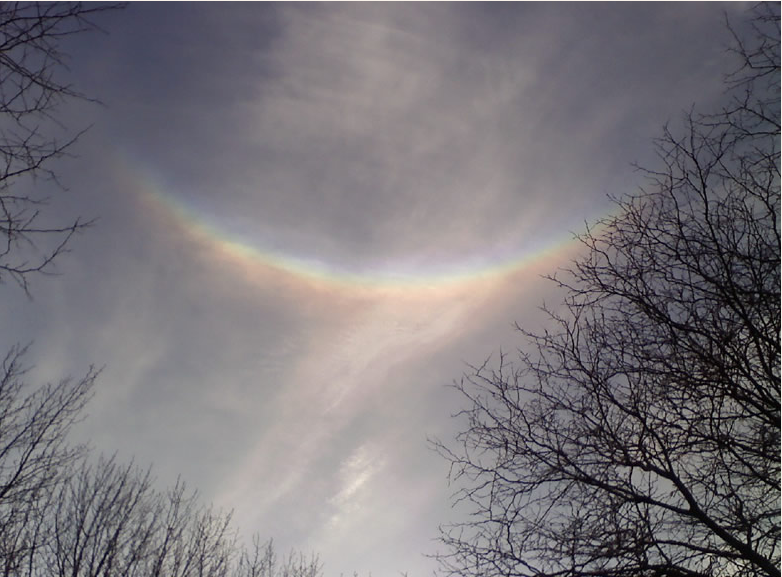Winter Circumzenithal Arc
Winter Circumzenithal Arc: A Spectacular Atmospheric Phenomenon
Have you ever looked up at the winter sky and been captivated by a stunning display of colors and arcs? One such phenomenon that occurs during the winter months is the Winter Circumzenithal Arc (CZA). While it may not be as well-known as its counterpart, the rainbow, the CZA is equally breathtaking and worth admiring. In this article, we will delve into the details of this fascinating atmospheric optical phenomenon and explore what makes it so unique.
Understanding the Winter Circumzenithal Arc
The Winter Circumzenithal Arc is a celestial spectacle that occurs when sunlight interacts with ice crystals in the atmosphere. To witness this extraordinary display, the sun must be lower than 32°, and an altitude between 15 and 25° provides the best conditions. When these criteria are met, six-sided plate-shaped ice crystals, with their large faces nearly horizontal, generate the beautiful arc that graces the winter sky.
The Role of Ice Crystals
Ice crystals play a crucial role in the formation of the Winter Circumzenithal Arc. These crystals can be found in high cirrus clouds or even closer in low-level diamond dust. As sunlight passes through these ice crystals, it undergoes refraction and dispersion, causing the light to split into its constituent colors. The result is a vivid display of colors in a circular arc formation.
Factors Affecting Visibility
Several factors influence the visibility of the Winter Circumzenithal Arc. One key factor is the angle of the sun. The lower the sun is in the sky, the higher the chances of witnessing this atmospheric phenomenon. Additionally, atmospheric conditions, such as the presence of high cirrus clouds or diamond dust, can enhance or hinder visibility. The purity and size of the ice crystals also play a role in the intensity and clarity of the arc.
A Kaleidoscope of Colors
One of the most striking aspects of the Winter Circumzenithal Arc is its vibrant display of colors. Similar to a rainbow, the arc showcases a range of hues, including reds, oranges, yellows, greens, blues, and violets. However, unlike a rainbow, the colors of the CZA are more saturated and vivid. This phenomenon is due to the specific angles at which light interacts with the ice crystals, resulting in a more concentrated and intense color palette.
Comparing the Winter Circumzenithal Arc and Sundogs
While observing the Winter Circumzenithal Arc, you may also notice the presence of sundogs. Sundogs, or parhelia, are bright spots of light that appear on either side of the sun. These optical phenomena are caused by the refraction and reflection of sunlight by ice crystals. Sundogs and the Winter Circumzenithal Arc often occur together because they share similar atmospheric conditions and ice crystal formations.
Cultural Significance
Throughout history, atmospheric optical phenomena like the Winter Circumzenithal Arc have captivated people's imaginations and sparked cultural interpretations. In Norse mythology, circumzenithal arcs were believed to be a bridge between Earth and Asgard, the realm of the gods. In some Native American cultures, these arcs were seen as celestial messengers or omens. Today, they continue to inspire awe and wonder among sky gazers worldwide.
Capturing the Winter Circumzenithal Arc
If you're fortunate enough to witness a Winter Circumzenithal Arc, consider capturing its beauty through photography. To best capture this ethereal phenomenon, use a wide-angle lens to capture the entire arc. Adjust your camera settings to ensure proper exposure and focus on the details of the ice crystals within the arc. Experiment with different angles and compositions to create truly breathtaking images.
Appreciating the Beauty of Nature
The Winter Circumzenithal Arc serves as a reminder of the beauty and complexity of the natural world. By understanding the science behind this phenomenon, we gain a deeper appreciation for the intricate interactions between light and ice crystals in our atmosphere. So, the next time you find yourself outside on a winter's day, take a moment to look up and marvel at the awe-inspiring Winter Circumzenithal Arc, a true testament to the wonders of our world.
Conclusion
The Winter Circumzenithal Arc is a remarkable atmospheric optical phenomenon that occurs during the winter months. It is caused by the interaction of sunlight with six-sided plate-shaped ice crystals in the atmosphere. With its vibrant colors and graceful arc formation, this celestial spectacle never fails to captivate those lucky enough to witness it. Whether you're a photographer, a sky enthusiast, or simply someone who appreciates the beauty of nature, the Winter Circumzenithal Arc is a sight that should not be missed. So, remember to keep an eye on the winter sky and be prepared to be amazed by this enchanting display of light and ice.

Winter Circumzenithal Arc captured by Mark Damato. �Mark Damato, shown with permission.
The low sun of winter offers more opportunities to see fine CZAs and sundogs.
For a CZA to be seen the sun must be lower than 32° and an altitude between 15 and 25° is best.
Six sided plate shaped ice crystals drifting with their large faces nearly horizontal produce the arc.
The crystals may be in high cirrus cloud or much closer in low level diamond dust.
Note: this article has been automatically converted from the old site and may not appear as intended. You can find the original article here.
Reference Atmospheric Optics
If you use any of the definitions, information, or data presented on Atmospheric Optics, please copy the link or reference below to properly credit us as the reference source. Thank you!
-
<a href="https://atoptics.co.uk/blog/winter-circumzenithal-arc/">Winter Circumzenithal Arc</a>
-
"Winter Circumzenithal Arc". Atmospheric Optics. Accessed on April 19, 2024. https://atoptics.co.uk/blog/winter-circumzenithal-arc/.
-
"Winter Circumzenithal Arc". Atmospheric Optics, https://atoptics.co.uk/blog/winter-circumzenithal-arc/. Accessed 19 April, 2024
-
Winter Circumzenithal Arc. Atmospheric Optics. Retrieved from https://atoptics.co.uk/blog/winter-circumzenithal-arc/.